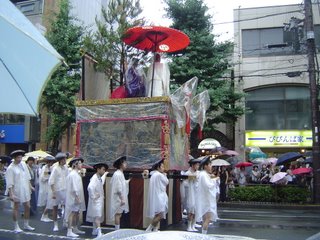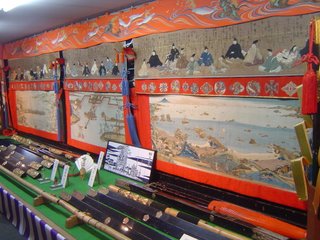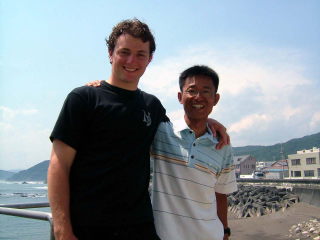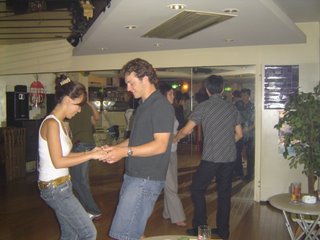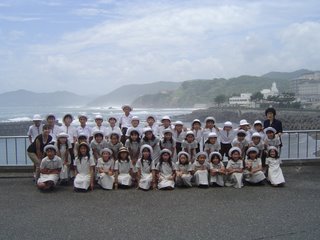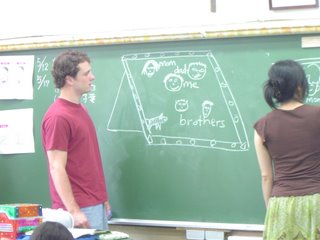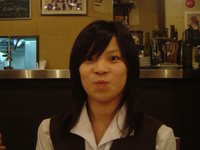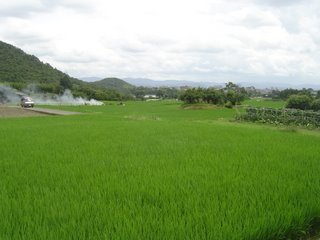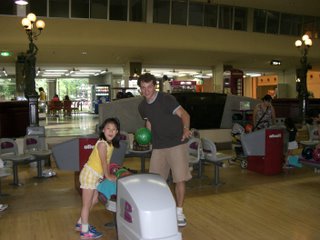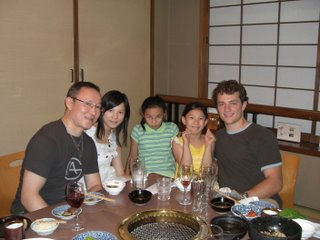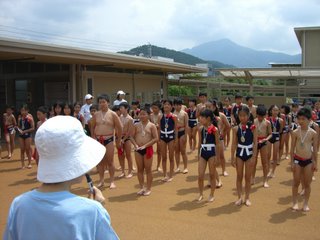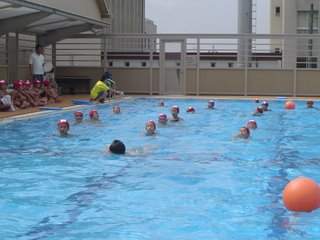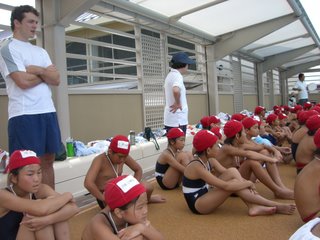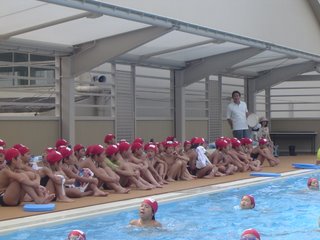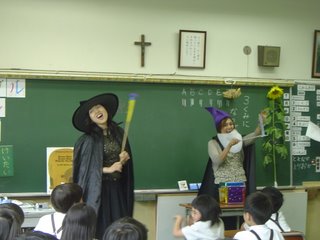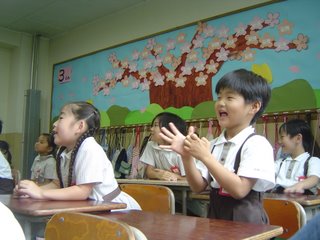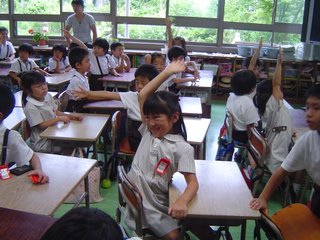This morning we had a simple breakfast of bread, rolls, sausage, and fruit. I am excited that today is Friday, but my time here is growing ever more slim. My last couple weeks here will go very quickly because next week I will travel to the Sea for the swimming camp, and the following week is a short week in which each school day only goes until lunch! I have been trying to make a list of things I still want to do in Kyoto so that I may find the time before I go. No matter what I end up doing the rest of my time here, I want to be sure and enjoy it.
This morning we had a morning meeting at the beginning of the day. We always begin with a prayer, and today I read from the Gospel of Matthew (9:12,13). The part I read aloud ended with Jesus' response when asked why he sits with tax collectors and sinners: "Those who are well have no need of a physician, but those who are sick. But go and learn what this means, 'I desire mercy and not sacrifice.' For I did not come to call the righteous, but sinners, to repentance." It is a part of the Gospels I am familiar with, and it was nice to be part of the morning prayer and share such a powerful message with the other teachers.
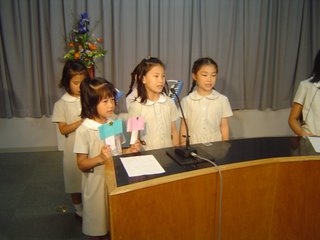
After the morning meeting I rushed over to the television studio because I knew that Misaki, one of the girls I am currently staying with, would be hosting the show. I wanted to watch her share her experience at Yamanoie this past week. I also wanted to take some pictures so I would have them to share with the Arai family. The show was a success. I went to my office for a few minutes and worked before heading out to find Afrela Sensei. To my surprise, Afrela Sensei and most of the other English staff we not here today! Mr. Yukita administered some English speaking tests, so the students did not have regular English class today. It is time like these that a simple memo on my desk would be appreciated.
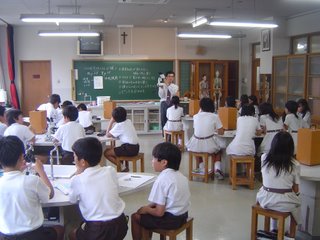
Instead of English, I joined the science classes today. Endo Sensei was kind enough to let me join his class of fifth graders. First, I must describe the seemingly limitless resources and equipment available for the students here at Notre Dame Elementary (keep in mind that this is an
elementary school). In the back of the science classroom there are glass cases filled with equipment and supplies for exploring the world of science. There are cases of preserved organisms for life science, digital scales, geology displays, voltmeters and other electric equipment, and a great quantity of chemistry equipment: Bunsen burners, beakers, flasks, ceramics, graduated cylinders, etc. My elementary school did not even have a flask, if I remember correctly. Typically in the United States, these sorts of lab materials only become available from junior high and above. Clearly the Japanese have a stronger focus on the sciences. In some of the fourth grade classrooms, they are even building solar-powered remote-control cars!! If that is not a fun and educational science project, then I don't know what is. Outside the science room there are fish tanks and a computerized weather station for additional learning opportunities. Next to the weather station is a large display showing a bird's-eye view of the school campus; There is a panel which has buttons for each type of plant on the landscape, and if you press the button, a light shows where on campus the type of plant is located. It appears to me that this interactive landscape display was created by the students themselves, perhaps a few years ago. To put it simply, this school has a great science program.
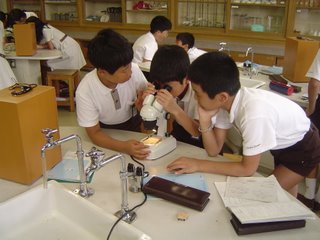
Today the students reviewed how to use the microscopes in the laboratory. Since the classes are so large, each microscope was shared by a group of four or five students. The assignment for today's lessons was for the students to observe fish eggs under the microscope, draw the organisms, and write some of their observations in their lab notebooks. I felt right at home helping the students find the eggs under the microscope, since I taught life science at Lombardi Middle School back home using a lot of microscope observations (Thank you Cindi!). When some of the students were finished with their observations,
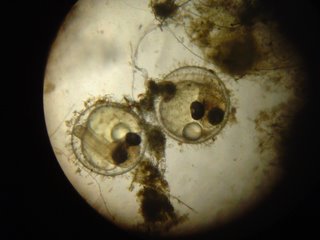
I increased their magnification and showed them the microorganisms swimming in the water. I saw a lot of Paramecium in the water, so I taught the kids about them and wrote the name in some of their notebooks. Seeing that I was writing in the lab books, the rest of the students started asking me to sign their notebooks. They thought I was signing autographs or something, but really I was trying to teach the advanced kids a bit more. I had fun in the science classes and was able to help them too.
After lunch with the second graders, I planned some activities for today's English club. Friday's are always shortened days, but then most of the students attend some type of club available here at school. Usually I join one of the sports clubs, but today I taught the English club instead. Mr. Yukita left the planning and teaching to me. First, we warmed up with a three-hint quiz. Basically, I think of something and give the students three hints. They can ask me questions about it (color, shape, etc.) and they have to figure out what the object is. I used some hard ones today, including rain drops, the ocean, and stars. The star mystery led into the first story I read today, the Star Weaver tale. Today is a holiday called
Tanabata, and the story of the Star Weaver is the folk tale upon which the holiday is based: Orihime, the daughter of the God of the sky, used to weave cloth for the Gods on a machine called a tanahata. She fell in love with a man named Hikoboshi, who raised cows. As the two spent more and more time together, they neglected their work. This made Tenkou, the God of the sky, angry and he sent Orihime to the other side of the Amanogawa (the Milky Way, thought of as a river in the story). If the two lovers work hard, then Tenkou lets them meet only once a year, on July 7th. Orihime is thought of as the star Vega, and Hikoboshi as Altair. On July 7th, the two stars meet in the sky.
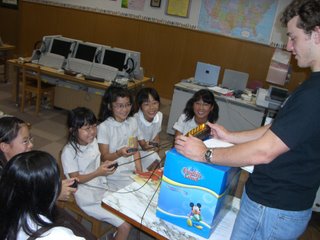
I am sure the students know the story of the holiday, but I thought it would be worthwhile to share the story in English and have them listen. After reading the story I had a quiz time. Since this was my first experience with the Friday English Club, I was not sure what to expect as far as age and ability level. As a result, my questions about the story were too difficult for the students. We some hints, we worked through the questions and then moved on to the next story. This time I read a book called
Tough Boris, by Mem Fox. The students seemed more interested in that book. It is about a pirate, and it uses new adjectives to describe Boris. I introduced each new word and asked the students what they thought it meant. From the context and from the pictures in the book, the students were able to guess the meaning accurately. After reading, we played a quiz game once again.
When the quiz was over, Mr. Yukita changed our roles: the students became the teachers and I became the student. The students taught me Japanese words using familiar pictures on a PowerPoint. It was fun to have the students teach me and I think they really enjoyed teaching me. I learned a few new terms, and perhaps the students were able to draw some clear connections between their Japanese and English vocabulary.
After school, Yoko, Misato, Misaki, and I went to a video rental store and picked out some movies for tonight. We rented
Mr. and Mrs. Smith and
March of the Penguins. Tonight we all watched
Mr. and Mrs. Smith and ate pizza! It was a nice relaxing night and it is fun just hanging out with the family.
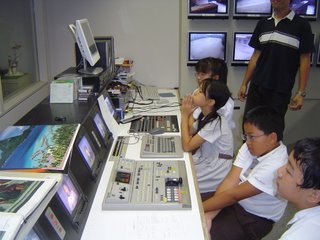 My last week started Sunday technically, but today was the first school day of my last week. Ryota was sick this morning, so he didn't go to school with me. He was soaked yesterday in the cold rain, so I am not surprised that he is sick. Before going to school I made a few important calls. One to my friend Josh, who I will be climbing Mt. Fuji with on Friday. The second call was to my brother Justin, who lives in Saitama, Japan. I will be staying with Justin, his wife Asako, and their son Tiger starting this coming Monday.
My last week started Sunday technically, but today was the first school day of my last week. Ryota was sick this morning, so he didn't go to school with me. He was soaked yesterday in the cold rain, so I am not surprised that he is sick. Before going to school I made a few important calls. One to my friend Josh, who I will be climbing Mt. Fuji with on Friday. The second call was to my brother Justin, who lives in Saitama, Japan. I will be staying with Justin, his wife Asako, and their son Tiger starting this coming Monday.
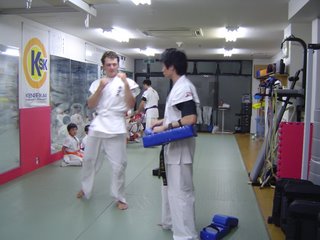
 I ate lunch with the students today, and enjoyed every minute. When I finished my meal, I worked my way around Marion Hall, saying hello to all of the students. This week classes at Notre Dame end at noon, so that the home room teachers can have parent-teacher conferences. Reiko picked me up, and we went home. Ryota was still feeling a little sick, but better than the morning. I worked for a while, called my parents to tell them I survived the long-distance swimming camp, and watched Ryota until Reiko came back from a meeting at school. Just after four o'clock we drove to Ryota's karate class. The sensei had me take part in the class as well, suiting me up in a karate kimono and everything. It was fun doing karate again. I really loved the part where we actually got to kick the teacher. Of course he was wearing pads, but it was fun. Some of the kids even practiced full contact fighting., which was a lot of fun to watch. I was shocked to see them using hard, high kicks to the head and everything! After karate, we bought my ticket for the Shinkansen (bullet train), which I will be leaving Kyoto on Thursday evening.
I ate lunch with the students today, and enjoyed every minute. When I finished my meal, I worked my way around Marion Hall, saying hello to all of the students. This week classes at Notre Dame end at noon, so that the home room teachers can have parent-teacher conferences. Reiko picked me up, and we went home. Ryota was still feeling a little sick, but better than the morning. I worked for a while, called my parents to tell them I survived the long-distance swimming camp, and watched Ryota until Reiko came back from a meeting at school. Just after four o'clock we drove to Ryota's karate class. The sensei had me take part in the class as well, suiting me up in a karate kimono and everything. It was fun doing karate again. I really loved the part where we actually got to kick the teacher. Of course he was wearing pads, but it was fun. Some of the kids even practiced full contact fighting., which was a lot of fun to watch. I was shocked to see them using hard, high kicks to the head and everything! After karate, we bought my ticket for the Shinkansen (bullet train), which I will be leaving Kyoto on Thursday evening.